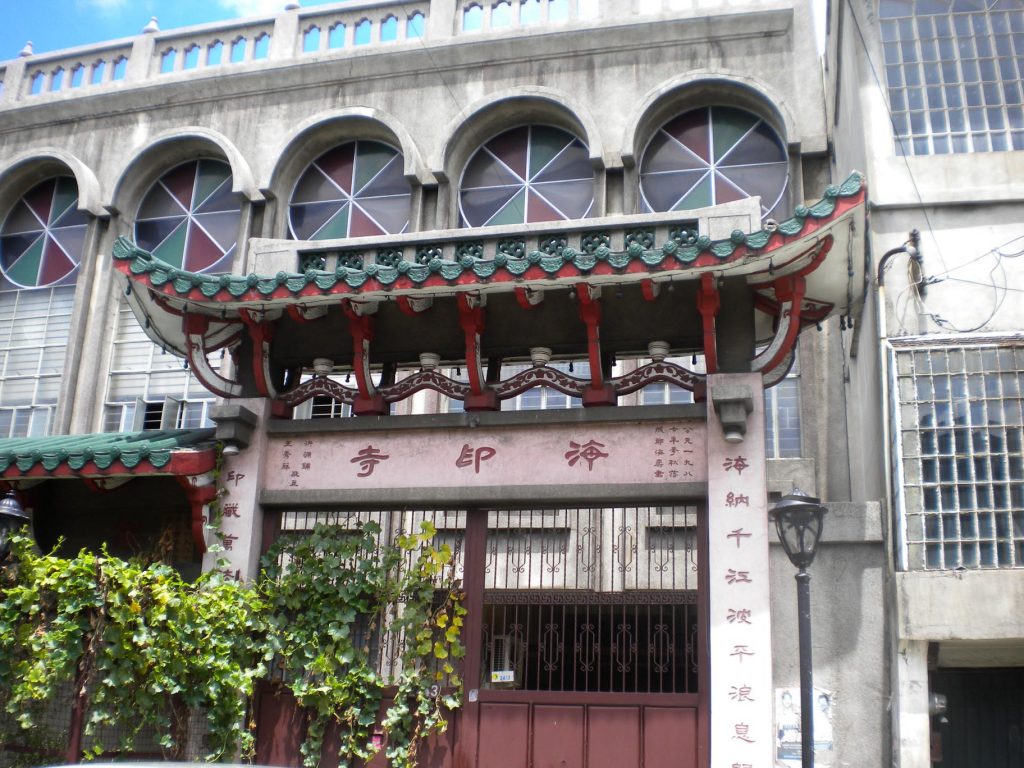Editors Note: This is the fourth of a series about the 36 Chinese Buddhist temples of the Philippines. Much of the information is from a thesis of Venerable Chuanmiao (Hsuan Chuang University, 2008), a Buddhist monk affiliated with the Thousand Buddha Temple in Quezon City.
4. Hai En Temple (海印寺)
2443 Severino Reyes St., Sta. Cruz, Manila | Tels.: 254-0550 • 251-0625
A temple of the same name existed in Gucha, Quanzhou (泉州古刹), where lay sister Yuanjing (元敬), born in 1930, lived since age five.
In 1948, she went to Xiamen’s Nanputuo Temple (南普陀寺) and took Bodhisattva vows under Master Xingyuan.
Xinyuan sent her to train at the Juehua Buddhist Institute (覺華佛學院) which he founded for the formation of lay sisters.
In 1957, she traveled to Hong Kong and three years later, Xingyuan asked her to go to Manila with lay sister Zhengyi (正義).
They first assisted Xingyuan at Seng Guan Temple. In 1962, after Xingyuan passed away, Ruimiao (瑞妙 the first to propagate Buddhism in the Philippines) invited them to move to Che Wan Temple where they stayed until 1968.
Yuanjing and Zhengyi rented an apartment on Reina Regente Street in 1968, where they maintained a small chapel and gathered a lay community around their spiritual practice.
By 1976, the community had grown and two buildings on Severino Reyes St. were purchased and named after Yuanjing’s original temple in Quanzhou.
The two lay sisters accepted the guidance of Seng Guan Temple monks, who helped them convert the buildings into proper temple facilities.
The work was completed only in 1987, although the community had been living there since 1976. At present, 10 lay sisters live there under Yuanjing’s leadership, plus a nun who, with her sister, grew up in the temple.

Main buildings. The temple has three floors. The ancestral hall and refectory are on the ground floor, and the main shrine to the Buddhas is upstairs. There are smaller altars to Guanyin and Maitreya.
Leadership and primary activities. At first, Yuanjing asked Xingyuan to be the titular abbot of the temple. After his death, she assumed the temple’s leadership, assisted by Zhengyi. The temple took in several young girls left at the temple by their families for various reasons.
The girls were brought up in the temple’s Buddhist environment but were not obliged to become monastics when they grew up.
Lay sister Chongcheng (崇城) and the nun Zongdao (宗道), both of this temple, work at the Philippine Academy of Sakya. Zongdao grew up in the temple; Chongcheng grew up in a Buddhist family in Manila and became a lay sister as an adult. Yuanjing had a special devotion to the Bodhisattva Ksitigarbha, also known as the Earth Store Bodhisattva, in charge of the netherworld in Buddhist cosmology.
The temple devotees gather on the 28th of every lunar month to chant this Bodhisattva’s sutra, with the major celebration on the 28th of the seventh month, his feast day.
Other feast days in the Buddhist calendar are also duly marked. — First published in Tulay Fortnightly, Chinese-Filipino Digest 25, no. 17 (February 5-18, 2013): 8.





